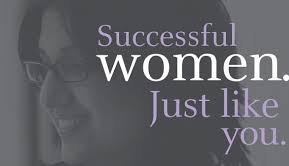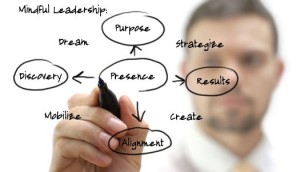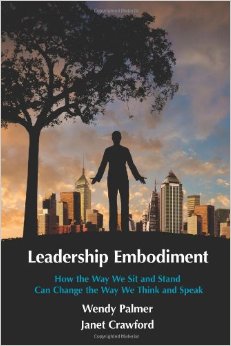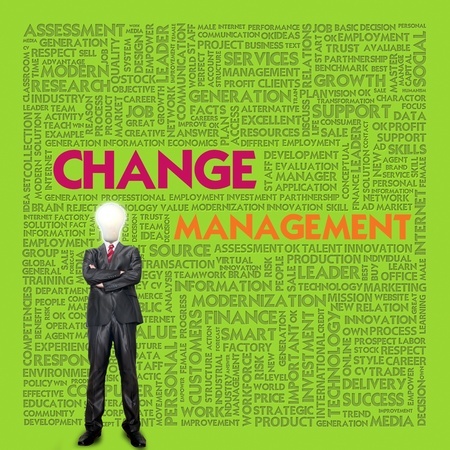 When smart women leaders decide to become more skillful, they look to mindfulness practices for support…and its a very good thing!
When smart women leaders decide to become more skillful, they look to mindfulness practices for support…and its a very good thing!
Cultivating mindfulness allows you to “attune” to what is happening – not just “see” it. That means noticing the tiny details – a muscle tightening in someone’s jaw, the temperature of the room rising by 1 degree, the body language of the person on your left shifting, the increased blink rate in your favorite direct report’s eyes and make sense of it – all this while carrying on.
And why is noticing important? Because it allows you to respond appropriately! That’s attuning – an almost musical adjustment to the circumstances in and around you like a well orchestrated dance. And like a dance you’ve practiced over and over, it becomes automatic at some magical point – you know longer need to “think” about it.
Naturally, when you’re leading a meeting or presenting to a group, you’re experiencing a bit of nervousness (unless you’ve had vast experience or are made of brick). Some of that nervous energy is great – gives you a flush of aliveness and keeps your edge sharp. Too much, though, closes down some important channels.
When you’re very nervous, you can’t attune to the folks in the room with you or note the highly subtle changes taking place in people or on the energy of the room as you speak. Get anxious enough andy you can’t even tell where the whiteboard is or whether there is one!
And how strategic can you be when you’re awash in self doubt or worse, self-flagellation? You can’t access your diamond-like clarity or your juicy creative energies when constricted by anxiety or fear.
Why?
Your nervous system sends messages to your brain to conserve energy, a subtle decline in the amount of gas you’re pumping. And if gas is the fuel you need, you won’t get very far without it, right?
If you haven’t cultivated the capacity to take in large amounts of very subtle data, synthesize it and use it to adjust your message, you’re caught. Adjusting your message doesn’t mean changing direction – not at all – it means, being responsive by altering your pace, perhaps adjusting your tone, changing volume, or adjusting eye contact, perhaps adjusting the amount of space – moving closer to or farther from someone – all this, to make your message land more effectively.
If you cannot adjust and speak coherently at the same time, you’ll sound automated – like a valedictorian delivering a speech, rather than as a leader sharing perspective, ideas, information or seeking them. Your attention will ping pong back and forth between your words and your tension and no adjustments will be possible.
Most importantly, you won’t get caught taking everything so personally. You can – hold a wider perspective. Without blowing this event up into a “life or death” drama, you can relax, breath, let your endorphins loose. And guess what? You’ll be more approachable and more effective.
As you cultivate this capacity, not only will you be able to forgive yourself and others more readily – noticing that life is happening all the time so this event isn’t a trigger, you’ll develop more compassion for our human condition.
Here’s where mindfulness comes in. Practicing every day has many great benefits. First, you can stay calm in the midst of chaos – not because it won’t arise, but because you can quickly return to center. There’s enough research now to prove how your brain is effected by consistent, ongoing practice.
Next, the freedom from many conditioned fears, opens you up. And when open, you take in more – more of what is right in front of you but so subtle you could easily miss it.
In addition, mindfulness allows you to sense yourself – quickly. If a question is raised as you speak, or an objections is made, you notice how you react – for example, you might contract in the pelvis, grow tense in the jaw or clench your fingers. Knowing this is happening allows you to release yourself back into a productive stance – more curious, open, less defensive. This in turn, changes the energy around you and invites others to also relax – all -on an unconscious level.
Attuning to the different personalities, who are showing up out of their own conditioned patterns, keeps you from projecting fears onto them. Example, John interrupts and you immediately think, he hates my idea , when John is perhaps an oppositional learner – seeing first what is out of sync before resting into the overall picture. Not taking John’s interruption personally, and not allowing fear to strangle your voice, creates space to regroup and explain clearly, confidently.
Mindfulness isn’t a book you read, however. It is a way of walking through the world and leading your team, organization or business. And it requires a commitment. Like building any habit, you have to be consistent until it becomes a natural part of your day -one you won’t have to think about or resist, like washing your face or brushing your teeth.
To cultivate this habit, it helps to pick a time of day and place to practice. Repeating it daily at the same time and in the same place is an anchor that supports practicing on those days you’d rather do something else. It is far more useful to practice for a few minutes everyday than to sporadically spend an hour.
Finding a practice that suits you is easy these days. Youtube offers many “how to” videos with explicit instructions. Classes in mindfulness are offered in most cities. Instructors of yoga, tai chi and qigong can point you in the right direction too. And finally there are great books like Mindsight by Dan Siegle, a a clinical professor of psychiatry at the UCLA School of Medicine and Executive Director of the Mindsight Institute with dozens more coming out each year, to help
Taking charge, for women, doesn’t mean domineering or manipulating. It allows you stay real, stay kind and stay attuned to what is happening in and around you. So step up – here’s is an invitation to take charge of yourself, so you can better serve your team, group, family or company with confidence, clarity and compassion.
And if you’d like support, come join us on May 20th.
 Women are amazing – brilliant, creative, compassionate, kind. Yet often, when they step into positions of leadership, one of the hazards they face AND rarely notice are their speech habits – the ones that undermine them.
Women are amazing – brilliant, creative, compassionate, kind. Yet often, when they step into positions of leadership, one of the hazards they face AND rarely notice are their speech habits – the ones that undermine them. The reason many brilliant women struggle to fully inhabit their leadership has little to do with where they work. Or men! Even juggling family and career isn’t the main culprit. So what is?
The reason many brilliant women struggle to fully inhabit their leadership has little to do with where they work. Or men! Even juggling family and career isn’t the main culprit. So what is? So you think your body is just the container to get your mind from place to place? Wrong! Or you imagine great leaders come only from great schools? Wrong again. Or perhaps, you imagine they are just born that way? Sorry, wrong again! Or partially wrong…yes some leaders come naturally with an innate ability to tune into themselves, but most learn it along the way – like you and me – through experience, commitment and dedicated practice.
So you think your body is just the container to get your mind from place to place? Wrong! Or you imagine great leaders come only from great schools? Wrong again. Or perhaps, you imagine they are just born that way? Sorry, wrong again! Or partially wrong…yes some leaders come naturally with an innate ability to tune into themselves, but most learn it along the way – like you and me – through experience, commitment and dedicated practice. In a discussion group that I belong to the question was raised whether mindfulness can be measured in actual behavior and whether a mindful leader is a more effective one.
In a discussion group that I belong to the question was raised whether mindfulness can be measured in actual behavior and whether a mindful leader is a more effective one.


